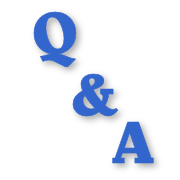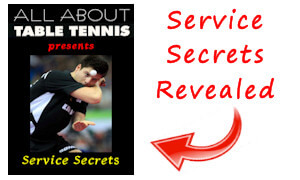You Are Here: Home » Visitor Questions » Table Tennis Serving Rules
Table Tennis Question about Serving Rules
This question about table tennis serving rules was submitted by
John from Sudbury, UK

My table tennis question relates to what the rules say regarding the service.
When you are serving, do you have to send the ball in between your opponent's corners of the table?
TABLE TENNIS EXPERT
REVEALS HIS SECRETS
Click Here For Details

Click here for a large selection of
table tennis equipment at Megaspin *

Click here for a large selection of
table tennis equipment at Bribar *
^ Top of page ^
----- Martin's Reply -----
By Martin Hughes
Owner and Editor
Thanks for your question John.
No, you do not have to send the ball in between your opponent's corners of the table.
If you're playing singles, the ball can hit any part of your opponent's half of the table after passing over the net.
As long as the ball hits the playing surface, the service will be legal.
The white lines are part of the playing surface.
However, if the ball touches the net during service, before touching the playing surface, the service must be replayed.
But if you're playing doubles, the service must only touch the right half court.
The only instance where the ball must go between your opponents corners of the table is if the receiver is a wheelchair user, then the service must exit between the two corners on his side.

But beware...
At the highest levels of the sport, players usually only send their service off the side of the table when they're trying to surprise their opponent or for an occasional variation to their usual service.
The reason they don't use it on a regular basis is because it often gives their opponent the opportunity to play the first attacking stroke.
The top players are very quick and have excellent anticipation, so they're often able to play a stroke with a full swing, rather than being limited to playing over the table.
The server will therefore usually lose the point if their opponent is able to play a full forehand stroke, but they'll have a better chance of success if they serve wide to their opponent's backhand side.
Here are a few examples of the world's best players sending their serves off the side of the table - with varying success...
TABLE TENNIS EXPERT
REVEALS HIS SECRETS
Click Here For Details

Click here for a large selection of
table tennis equipment at Megaspin *

Click here for a large selection of
table tennis equipment at Bribar *
^ Top of page ^
More Information
You'll find lots more details on my web site on the following pages...
Details about the playing surface...
www.allabouttabletennis.com/table-tennis-rules.html
Details about the serve...
www.allabouttabletennis.com/official-table-tennis-rules.html
www.allabouttabletennis.com/rules-in-table-tennis.html
Details about the serve in doubles...
www.allabouttabletennis.com/table-tennis-doubles-rules.html
| FIND MORE TABLE TENNIS QUESTIONS ASKED BY MY VISITORS | |
|---|---|
 |
|
| FIND MORE TABLE TENNIS QUESTIONS ASKED BY MY VISITORS |
|---|
 |
| Find more table tennis questions already asked and answered |
^ Top of page ^
| MORE PAGES ABOUT THE RULES OF TABLE TENNIS |
|---|
For more information about the rules of table tennis, take a look at my other articles which explain the Official
Laws of Table Tennis and the additional Regulations (for higher level play) in more detail...
The Laws of Table Tennis
Regulations (for higher level play)
General
Frequently Asked Questions
|
Click here for a large selection of
table tennis equipment at Megaspin *

Click here for a large selection of
table tennis equipment at Bribar *
^ Top of page ^
You Are Here: Home » Visitor Questions » Table Tennis Serving Rules
